MARKETING
Mining for Content Ideas – Next Level

Not to state the obvious, but as marketers, part of our job is to create content. Whether it’s in the form of blog posts, landing pages, social media posts, emails, newsletters, and so on – there’s no way to get around it. It is a critical component of our job. And sometimes, it can be challenging to come up with new ideas or ways to iterate on old ones. With the world consuming content at lightning speed, it is becoming even more difficult to keep up with the expectation of turning out fresh content.
We’ve recently published some excellent pieces on the Moz Blog all about content distribution and strategy, including the Whiteboard Fridays “How to Maximize Content” and “A Content Engine that Drives Revenue” (both from Ross Simmonds). And, as I’m sure I don’t have to tell you, content ideation and inspiration can come from anywhere. But what if I told you that you can also use the Moz tools to mine for content ideas? Let’s dig into different ways to use the Moz tools to supplement our content strategies.
Find gaps in your existing content
When supplementing or modifying your content strategy, a good place to start is by examining your existing content and finding the gaps. This can help identify new content ideas and areas where your content strategy may be missing key opportunities to thrive.
The Keyword Gap tool in Moz Pro allows you to enter your site and up to 3 competitors to identify Keywords to Improve and Top Competing Content.
Pro tip: Not sure who your online competitors are? Or just want to confirm and scope out who they may be? Check out the True Competitor tool to find out.
The Keywords to Improve section is instrumental when identifying gaps in your existing content strategy. After entering the sites you’d like to compare, the tool will list keywords for which you and your competitors rank. You can then use the filter option to see only specific segments of keywords. For example, we may want to see only keywords where we’re ranking on the second page to identify opportunities for content improvements. We will even show you the Traffic Lift for those keywords, which is the amount of traffic we estimate you can gain by overtaking your competitor in the SERP.
Another great use case for this tool is to identify new content ideas. Let’s say we’re working on building out the “best of” section of our foodie blog; we can filter to see keywords that include “Best,” as seen in the screenshot below. We can then identify keywords for which we’re not ranking, but our competitors are and work to build content around them. In this case, we’re not ranking for “Best Pizza in Los Angeles,” so we may want to see about creating a blog post about this topic.
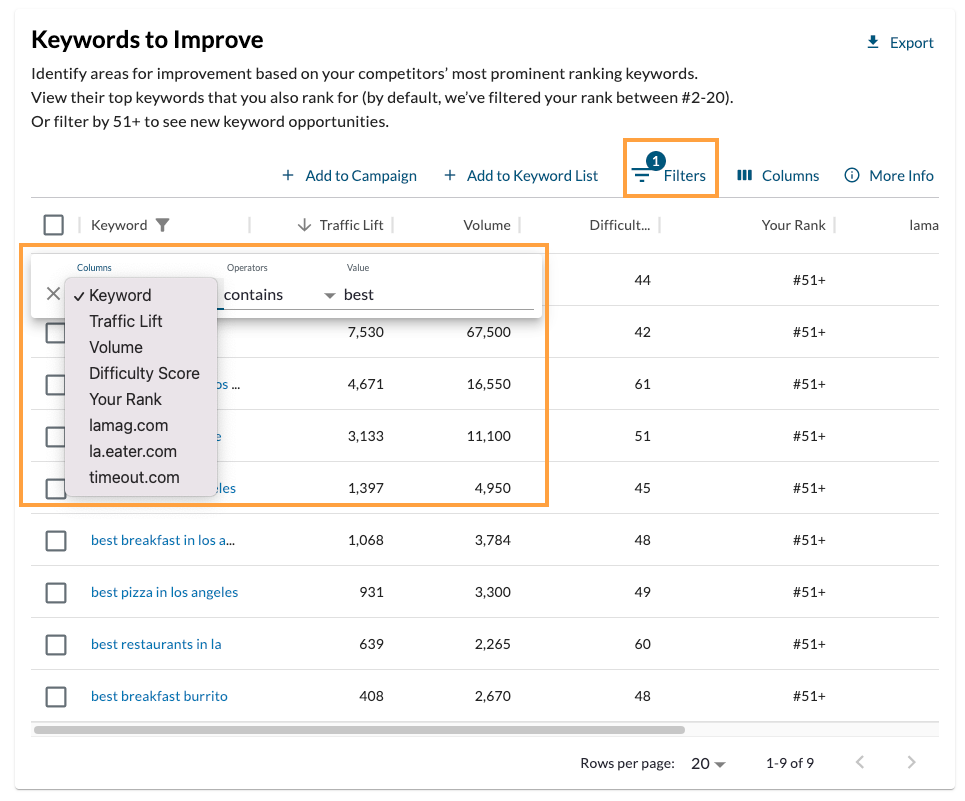
Spotting these content gaps can strengthen your content strategy. It can not only help spark ideas for new content but also help identify places where your content can be improved or refreshed for better performance.
Identify what type of content is performing
One of the best places to get ideas for content is to see what kind of content is already out there and performing. Top Competing Content in Keyword Gap can provide insight into what is performing well by listing content your competitors rank for with the Content URL and Top Ranking Keywords.
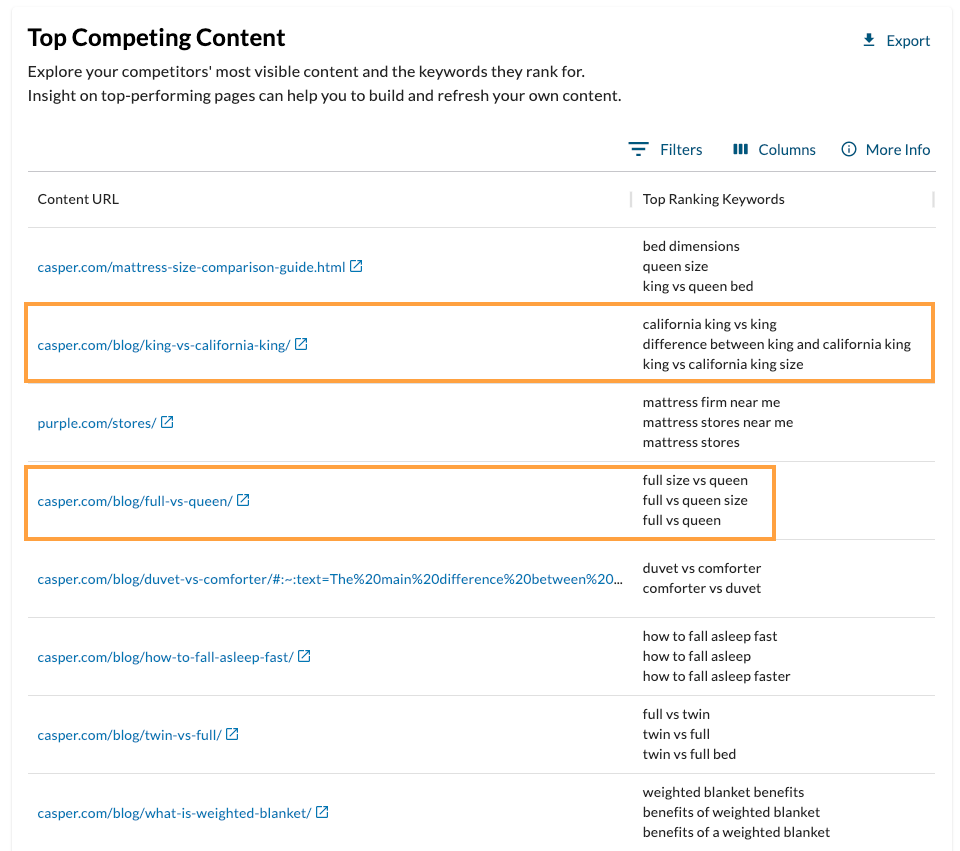
In this example, we can see that one of the competitors I’ve entered ranks well for keywords related to choosing a mattress size and, perhaps more importantly, that the content ranking is from their blog. We can now look at the blog posts themselves to get an idea of what format has been successful for them and what information they are including. We can ask ourselves:
-
Is this a topic we can cover on our site?
-
Do we already cover this, but it’s not ranking as well?
-
Is there a way we can improve the content or add a different perspective, format, or content type to the space?
The possibilities are endless!
Spot tangential content ideas
Sticking with Top Competing Content in Keyword Gap, let’s see if we can spot some ideas for tangential content. As Amanda Milligan discusses in her Whiteboard Friday episode, content ideas which aren’t directly related to your product can often lead to positive outcomes like links, social shares, and brand awareness. These peripherally related topics can supplement your content strategy and help create a well-rounded library of assets.

Sticking with our mattress company example, let’s say we are looking for content ideas to help build out our newly launched blog. We may know that there is value in creating pieces around mattress-related topics like deciding on a mattress size or determining what firmness would be best, but what tangential content ideas can we identify in our research? The example above shows that our competitors are ranking for content related to topics like weighted blankets and sleep hygiene. These could be great opportunities for me to create new content not directly related to mattresses but still related to the sleep industry.
Uncover hidden gems
Just like content creation, keyword research is a fundamental part of SEO and marketing strategies. And as you’re out there digging into things like search volume, difficulty, and SERP analysis, you may be able to uncover some hidden gems to inform your content strategy as well.
Hopping over to Keyword Explorer, we can mine for content ideas in the Keyword Suggestions section of the tool. Keyword Suggestions will provide a list of keywords related to the seed keyword entered, sorted by Relevancy to the original term. You can also apply filters for the source type, grouping preferences, and volume to further define your results.
Let’s start by looking at the option to filter titled Display keyword suggestions that. This filter defaults to Include a mix of sources, but an option in the drop-down could be the ace up your sleeve when it comes to content ideation – the filter option called are questions. By selecting are questions, we can see a list of the types of questions searchers ask in relation to our initial keyword.
In this example, consider that we work for a real estate agency and are researching content related to buying a house. Filtering our keyword suggestions by are questions will provide us with specific content ideas related to what people ask when buying a home. This can offer a gold mine of content ideas to flesh out a real estate blog or website to help clients find the information they seek.
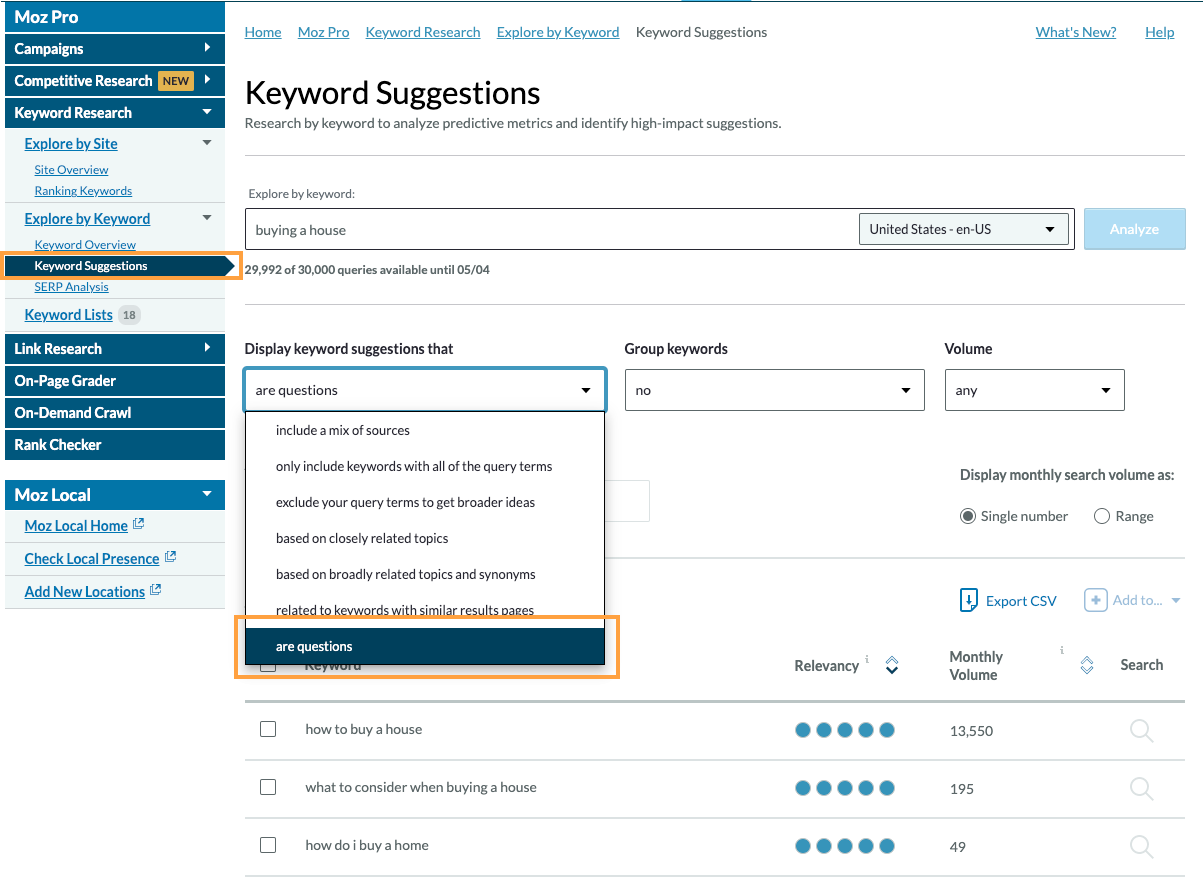
We can even take this research one step further by grouping our keyword suggestions by lexical similarity. Just a reminder here that lexical similarity refers to how closely related or similar the keywords in the group are. Low lexical similarity will result in fewer groups with more keywords since the tool will group keywords that are less similar.
Grouping keywords can help us identify additional keywords we may want to target and broad-match keywords that may be worth including in our content. Be mindful of over-optimizing, though! We want to avoid keyword stuffing and cannibalization since they may negatively impact rankings. That being said, consider the below example of how grouping keywords has helped to identify a few content gems.
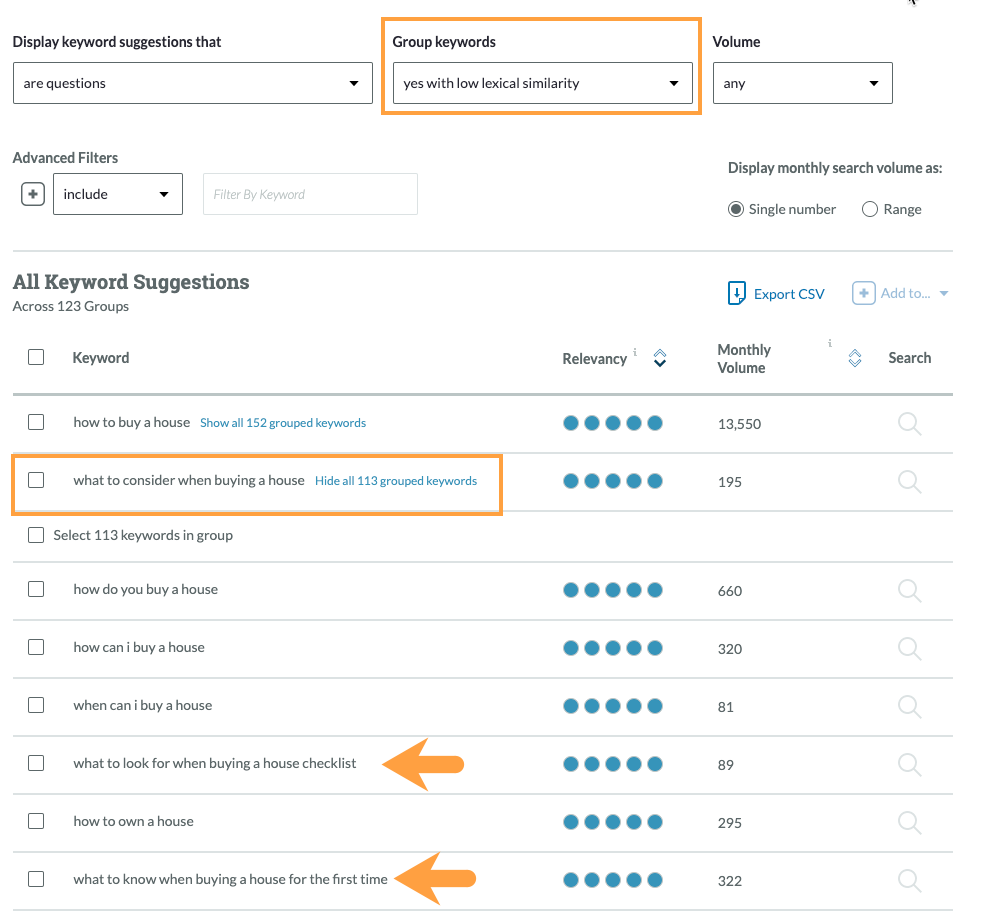
Using our previous example of “buying a house” as the seed keyword, we’ve grouped our keywords by low lexical similarity. Within the “What to consider when buying a house” group, there are two long-tail keywords which may be great inspiration for a new piece of content for our real estate agency – “what to look for when buying a house checklist” and “what to know when buying a house for the first time.” We can now take that information and create a dedicated resource or a blog post that includes a checklist for what to consider when buying a home for the first time and what the buying process looks like. Imagine the inspiration you can get from digging into these suggestions even further!
Scope out the competition
So far, we’ve identified content opportunities, uncovered new ideas, and found gaps in our existing strategy. But what about our competition? What are they doing? We touched on this a bit using the Keyword Gap tool but let’s dig in further. When modifying your content strategy, it’s important to understand what your competitors are doing and what their audience is engaging with. Although you won’t have access to their traffic data (unless they give you access to it, which is highly unlikely), there is a way you can get an idea of what content may be driving traffic to their site. Or, at the very least, what content is of high value. This is through link analysis. Moz offers quite a few ways to do this, but I’m going to highlight a feature which can help get us started with this research.
Top Pages in Link Explorer will return a list of the pages on a site with the most backlinks. This can provide insight into the types of content people find valuable on a site – pages with more links are more valuable. This is partly because backlinks are a ranking factor. Additionally, all those links provide benefits like traffic, brand exposure, and more.
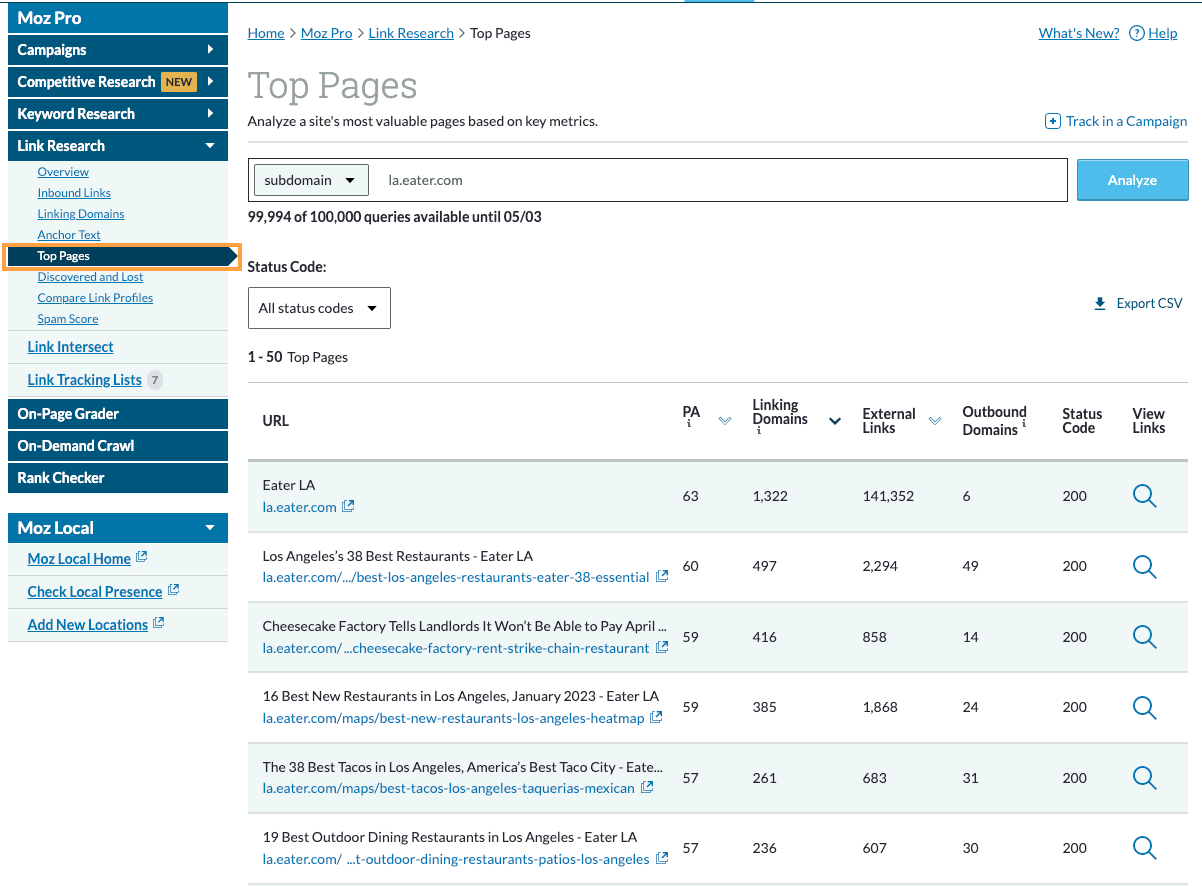
After inputting a competitor into Top Pages, we can get an idea of which pages on their site provide the most value. In the screenshot above, we can see that this particular competitor has a lot of “best of” articles which gain a lot of links. We can now explore these pages and see if there is an opportunity to create or modify content on our own site to meet similar demands.
Pro tip: Once you’ve created your content, you can use Link Intersect to find domains and pages linking to your competitors and not to you. This can offer a great way to supplement a link building strategy!
Discover opportunities for elevation
Just like creating new content, refreshing your existing URLs is essential to any content strategy. Elevating your existing content is like polishing your jewelry – it helps keep it in tip-top shape, extends the piece’s life, and keeps it relevant to your “collection.” There are many ways to identify and update content in your existing library, but here are two ways to get started (and find new content opportunities in the process).
First, let’s investigate featured snippet opportunities. Once we’ve created a Campaign in Moz Pro and are tracking keywords over time, we will have access to the SERP Features section. This part of the tool tracks SERP features included in the search results for your tracked keywords, including featured snippets.

Exploring which of our tracked keywords have featured snippets in the SERP can help us identify opportunities for content refresh and new pieces of content. When looking for opportunities for a content refresh, we can seek out keywords where we are ranking on the first page of the SERP but are not included in the featured snippet. In this case, the tool will provide insight into what page is included in the featured snippet and our current rank. This can make it easier to spot high-value pages with a chance of moving into that coveted top spot of the SERP.
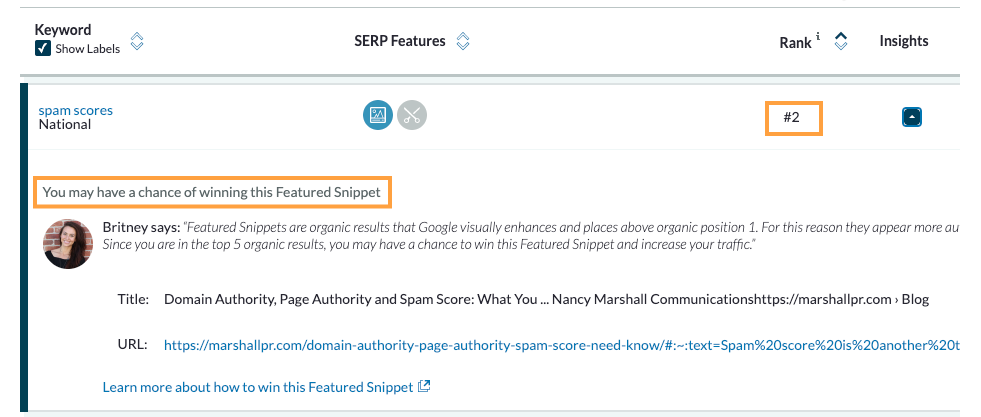
Alternatively, looking at which of our tracked keywords include a featured snippet but where we are not ranking on the first page (or at all) can help to identify possible opportunities for creating new, high-value content. We’ll just want to be sure to optimize for the featured snippet right from the start.
Pro tip: Export a CSV of the SERP Features data in your Campaign to sort and filter outside the app. If a SERP feature is marked Included in the CSV, it means your site is included in that particular feature. If it’s marked true it means the SERP feature is present for that keyword, but your tracked site isn’t included.
Next, we’ll pop over to the Page Optimization section of our Campaign. Although the primary purpose of this feature is to illustrate how well-optimized a page is for a particular keyword, there is a hidden gem that can help identify refresh opportunities, new content ideas, and tangential topics. The Content Suggestions tab will list keywords and topics often used on the top-ranking pages for the keyword we’re optimizing for.

In the above example, we’re optimizing for the keyword “best pillow.” Looking at the content suggestions, it may be a good idea to format this content as a list (like “11 best pillows”) or to include information about what types of sleepers would benefit from each pillow listed (like “side sleepers”). These content suggestions can also help us to find ideas for other pieces of content, tangentially related.
Find the sweet spot of innovation
If there’s one thing we can take away from this exploration of content ideation with Moz Pro, it’s that there are infinite ways to do it. This post only covers a handful of them; the reality is that the world (of content creation) is your oyster! The key is to find which features, tools, and processes fit best with your strategy and make them work for you. How do you use the tools to investigate new ideas? I’d love to hear about it!
MARKETING
Tinuiti Marketing Analytics Recognized by Forrester

Rapid Media Mix Modeling and Proprietary Tech Transform Brand Performance
Tinuiti, the largest independent full-funnel performance marketing agency, has been included in a recent Forrester Research report titled, “The Marketing Analytics Landscape, Q2 2024.” This report comprehensively overviews marketing analytics markets, use cases, and capabilities. B2C marketing leaders can use this research by Principal Analyst Tina Moffett to understand the intersection of marketing analytics capabilities and use cases to determine the vendor or service provider best positioned for their analytics and insights needs. Moffett describes the top marketing analytics markets as advertising agencies, marketing dashboards and business intelligence tools, marketing measurement and optimization platforms and service providers, and media analytics tools.
As an advertising agency, we believe Tinuiti is uniquely positioned to manage advertising campaigns for brands including buying, targeting, and measurement. Our proprietary measurement technology, Bliss Point by Tinuiti, allows us to measure the optimal level of investment to maximize impact and efficiency. According to the Forrester report, “only 30% of B2C marketing decision-makers say their organization uses marketing or media mix modeling (MMM),” so having a partner that knows, embraces, and utilizes MMM is important. As Tina astutely explains, data-driven agencies have amplified their marketing analytics competencies with data science expertise; and proprietary tools; and tailored their marketing analytics techniques based on industry, business, and data challenges.
Our Rapid Media Mix Modeling sets a new standard in the market with its exceptional speed, precision, and transparency. Our patented tech includes Rapid Media Mix Modeling, Always-on Incrementality, Brand Equity, Creative Insights, and Forecasting – it will get you to your Marketing Bliss Point in each channel, across your entire media mix, and your overall brand performance.
As a marketing leader you may ask yourself:
- How much of our marketing budget should we allocate to driving store traffic versus e-commerce traffic?
- How should we allocate our budget by channel to generate the most traffic and revenue possible?
- How many customers did we acquire in a specific region with our media spend?
- What is the impact of seasonality on our media mix?
- How should we adjust our budget accordingly?
- What is the optimal marketing channel mix to maximize brand awareness?
These are just a few of the questions that Bliss Point by Tinuiti can help you answer.
Learn more about our customer-obsessed, product-enabled, and fully integrated approach and how we’ve helped fuel full-funnel outcomes for the world’s most digital-forward brands like Poppi & Toms.
The Landscape report is available online to Forrester customers or for purchase here.
MARKETING
Ecommerce evolution: Blurring the lines between B2B and B2C

Understanding convergence
B2B and B2C ecommerce are two distinct models of online selling. B2B ecommerce is between businesses, such as wholesalers, distributors, and manufacturers. B2C ecommerce refers to transactions between businesses like retailers and consumer brands, directly to individual shoppers.
However, in recent years, the boundaries between these two models have started to fade. This is known as the convergence between B2B and B2C ecommerce and how they are becoming more similar and integrated.
Source: White Paper: The evolution of the B2B Consumer Buyer (ClientPoint, Jan 2024)
What’s driving this change?
Ever increasing customer expectations
Customers today expect the same level of convenience, speed, and personalization in their B2B transactions as they do in their B2C interactions. B2B buyers are increasingly influenced by their B2C experiences. They want research, compare, and purchase products online, seamlessly transitioning between devices and channels. They also prefer to research and purchase online, using multiple devices and channels.
Forrester, 68% of buyers prefer to research on their own, online . Customers today expect the same level of convenience, speed, and personalization in their B2B transactions as they do in their B2C interactions. B2B buyers are increasingly influenced by their B2C experiences. They want research, compare, and purchase products online, seamlessly transitioning between devices and channels. They also prefer to research and purchase online, using multiple devices and channels
Technology and omnichannel strategies
Technology enables B2B and B2C ecommerce platforms to offer more features and functionalities, such as mobile optimization, chatbots, AI, and augmented reality. Omnichannel strategies allow B2B and B2C ecommerce businesses to provide a seamless and consistent customer experience across different touchpoints, such as websites, social media, email, and physical stores.
However, with every great leap forward comes its own set of challenges. The convergence of B2B and B2C markets means increased competition. Businesses now not only have to compete with their traditional rivals, but also with new entrants and disruptors from different sectors. For example, Amazon Business, a B2B ecommerce platform, has become a major threat to many B2B ecommerce businesses, as it offers a wide range of products, low prices, and fast delivery
“Amazon Business has proven that B2B ecommerce can leverage popular B2C-like functionality” argues Joe Albrecht, CEO / Managing Partner, Xngage. . With features like Subscribe-and-Save (auto-replenishment), one-click buying, and curated assortments by job role or work location, they make it easy for B2B buyers to go to their website and never leave. Plus, with exceptional customer service and promotional incentives like Amazon Business Prime Days, they have created a reinforcing loyalty loop.
And yet, according to Barron’s, Amazon Business is only expected to capture 1.5% of the $5.7 Trillion addressable business market by 2025. If other B2B companies can truly become digital-first organizations, they can compete and win in this fragmented space, too.”
If other B2B companies can truly become digital-first organizations, they can also compete and win in this fragmented space
Joe AlbrechtCEO/Managing Partner, XNGAGE
Increasing complexity
Another challenge is the increased complexity and cost of managing a converging ecommerce business. Businesses have to deal with different customer segments, requirements, and expectations, which may require different strategies, processes, and systems. For instance, B2B ecommerce businesses may have to handle more complex transactions, such as bulk orders, contract negotiations, and invoicing, while B2C ecommerce businesses may have to handle more customer service, returns, and loyalty programs. Moreover, B2B and B2C ecommerce businesses must invest in technology and infrastructure to support their convergence efforts, which may increase their operational and maintenance costs.
How to win
Here are a few ways companies can get ahead of the game:
Adopt B2C-like features in B2B platforms
User-friendly design, easy navigation, product reviews, personalization, recommendations, and ratings can help B2B ecommerce businesses to attract and retain more customers, as well as to increase their conversion and retention rates.
According to McKinsey, ecommerce businesses that offer B2C-like features like personalization can increase their revenues by 15% and reduce their costs by 20%. You can do this through personalization of your website with tools like Product Recommendations that help suggest related products to increase sales.
Focus on personalization and customer experience
B2B and B2C ecommerce businesses need to understand their customers’ needs, preferences, and behaviors, and tailor their offerings and interactions accordingly. Personalization and customer experience can help B2B and B2C ecommerce businesses to increase customer satisfaction, loyalty, and advocacy, as well as to improve their brand reputation and competitive advantage. According to a Salesforce report, 88% of customers say that the experience a company provides is as important as its products or services.
Market based on customer insights
Data and analytics can help B2B and B2C ecommerce businesses to gain insights into their customers, markets, competitors, and performance, and to optimize their strategies and operations accordingly. Data and analytics can also help B2B and B2C ecommerce businesses to identify new opportunities, trends, and innovations, and to anticipate and respond to customer needs and expectations. According to McKinsey, data-driven organizations are 23 times more likely to acquire customers, six times more likely to retain customers, and 19 times more likely to be profitable.
What’s next?
The convergence of B2B and B2C ecommerce is not a temporary phenomenon, but a long-term trend that will continue to shape the future of ecommerce. According to Statista, the global B2B ecommerce market is expected to reach $20.9 trillion by 2027, surpassing the B2C ecommerce market, which is expected to reach $10.5 trillion by 2027. Moreover, the report predicts that the convergence of B2B and B2C ecommerce will create new business models, such as B2B2C, B2A (business to anyone), and C2B (consumer to business).
Therefore, B2B and B2C ecommerce businesses need to prepare for the converging ecommerce landscape and take advantage of the opportunities and challenges it presents. Here are some recommendations for B2B and B2C ecommerce businesses to navigate the converging landscape:
- Conduct a thorough analysis of your customers, competitors, and market, and identify the gaps and opportunities for convergence.
- Develop a clear vision and strategy for convergence, and align your goals, objectives, and metrics with it.
- Invest in technology and infrastructure that can support your convergence efforts, such as cloud, mobile, AI, and omnichannel platforms.
- Implement B2C-like features in your B2B platforms, and vice versa, to enhance your customer experience and satisfaction.
- Personalize your offerings and interactions with your customers, and provide them with relevant and valuable content and solutions.
- Leverage data and analytics to optimize your performance and decision making, and to innovate and differentiate your business.
- Collaborate and partner with other B2B and B2C ecommerce businesses, as well as with other stakeholders, such as suppliers, distributors, and customers, to create value and synergy.
- Monitor and evaluate your convergence efforts, and adapt and improve them as needed.
By following these recommendations, B2B and B2C ecommerce businesses can bridge the gap between their models and create a more integrated and seamless ecommerce experience for their customers and themselves.
MARKETING
Streamlining Processes for Increased Efficiency and Results

How can businesses succeed nowadays when technology rules? With competition getting tougher and customers changing their preferences often, it’s a challenge. But using marketing automation can help make things easier and get better results. And in the future, it’s going to be even more important for all kinds of businesses.
So, let’s discuss how businesses can leverage marketing automation to stay ahead and thrive.
Benefits of automation marketing automation to boost your efforts
First, let’s explore the benefits of marketing automation to supercharge your efforts:
Marketing automation simplifies repetitive tasks, saving time and effort.
With automated workflows, processes become more efficient, leading to better productivity. For instance, automation not only streamlines tasks like email campaigns but also optimizes website speed, ensuring a seamless user experience. A faster website not only enhances customer satisfaction but also positively impacts search engine rankings, driving more organic traffic and ultimately boosting conversions.
Automation allows for precise targeting, reaching the right audience with personalized messages.
With automated workflows, processes become more efficient, leading to better productivity. A great example of automated workflow is Pipedrive & WhatsApp Integration in which an automated welcome message pops up on their WhatsApp
within seconds once a potential customer expresses interest in your business.
Increases ROI
By optimizing campaigns and reducing manual labor, automation can significantly improve return on investment.
Leveraging automation enables businesses to scale their marketing efforts effectively, driving growth and success. Additionally, incorporating lead scoring into automated marketing processes can streamline the identification of high-potential prospects, further optimizing resource allocation and maximizing conversion rates.
Harnessing the power of marketing automation can revolutionize your marketing strategy, leading to increased efficiency, higher returns, and sustainable growth in today’s competitive market. So, why wait? Start automating your marketing efforts today and propel your business to new heights, moreover if you have just learned ways on how to create an online business
How marketing automation can simplify operations and increase efficiency
Understanding the Change
Marketing automation has evolved significantly over time, from basic email marketing campaigns to sophisticated platforms that can manage entire marketing strategies. This progress has been fueled by advances in technology, particularly artificial intelligence (AI) and machine learning, making automation smarter and more adaptable.
One of the main reasons for this shift is the vast amount of data available to marketers today. From understanding customer demographics to analyzing behavior, the sheer volume of data is staggering. Marketing automation platforms use this data to create highly personalized and targeted campaigns, allowing businesses to connect with their audience on a deeper level.
The Emergence of AI-Powered Automation
In the future, AI-powered automation will play an even bigger role in marketing strategies. AI algorithms can analyze huge amounts of data in real-time, helping marketers identify trends, predict consumer behavior, and optimize campaigns as they go. This agility and responsiveness are crucial in today’s fast-moving digital world, where opportunities come and go in the blink of an eye. For example, we’re witnessing the rise of AI-based tools from AI website builders, to AI logo generators and even more, showing that we’re competing with time and efficiency.
Combining AI-powered automation with WordPress management services streamlines marketing efforts, enabling quick adaptation to changing trends and efficient management of online presence.
Moreover, AI can take care of routine tasks like content creation, scheduling, and testing, giving marketers more time to focus on strategic activities. By automating these repetitive tasks, businesses can work more efficiently, leading to better outcomes. AI can create social media ads tailored to specific demographics and preferences, ensuring that the content resonates with the target audience. With the help of an AI ad maker tool, businesses can efficiently produce high-quality advertisements that drive engagement and conversions across various social media platforms.
Personalization on a Large Scale
Personalization has always been important in marketing, and automation is making it possible on a larger scale. By using AI and machine learning, marketers can create tailored experiences for each customer based on their preferences, behaviors, and past interactions with the brand.
This level of personalization not only boosts customer satisfaction but also increases engagement and loyalty. When consumers feel understood and valued, they are more likely to become loyal customers and brand advocates. As automation technology continues to evolve, we can expect personalization to become even more advanced, enabling businesses to forge deeper connections with their audience. As your company has tiny homes for sale California, personalized experiences will ensure each customer finds their perfect fit, fostering lasting connections.
Integration Across Channels
Another trend shaping the future of marketing automation is the integration of multiple channels into a cohesive strategy. Today’s consumers interact with brands across various touchpoints, from social media and email to websites and mobile apps. Marketing automation platforms that can seamlessly integrate these channels and deliver consistent messaging will have a competitive edge. When creating a comparison website it’s important to ensure that the platform effectively aggregates data from diverse sources and presents it in a user-friendly manner, empowering consumers to make informed decisions.
Omni-channel integration not only betters the customer experience but also provides marketers with a comprehensive view of the customer journey. By tracking interactions across channels, businesses can gain valuable insights into how consumers engage with their brand, allowing them to refine their marketing strategies for maximum impact. Lastly, integrating SEO services into omni-channel strategies boosts visibility and helps businesses better understand and engage with their customers across different platforms.
The Human Element
While automation offers many benefits, it’s crucial not to overlook the human aspect of marketing. Despite advances in AI and machine learning, there are still elements of marketing that require human creativity, empathy, and strategic thinking.
Successful marketing automation strikes a balance between technology and human expertise. By using automation to handle routine tasks and data analysis, marketers can focus on what they do best – storytelling, building relationships, and driving innovation.
Conclusion
The future of marketing automation looks promising, offering improved efficiency and results for businesses of all sizes.
As AI continues to advance and consumer expectations change, automation will play an increasingly vital role in keeping businesses competitive.
By embracing automation technologies, marketers can simplify processes, deliver more personalized experiences, and ultimately, achieve their business goals more effectively than ever before.
-

 SEO7 days ago
SEO7 days agoGoogle Limits News Links In California Over Proposed ‘Link Tax’ Law
-

 SEARCHENGINES6 days ago
SEARCHENGINES6 days agoGoogle Core Update Volatility, Helpful Content Update Gone, Dangerous Google Search Results & Google Ads Confusion
-

 SEO6 days ago
SEO6 days ago10 Paid Search & PPC Planning Best Practices
-

 MARKETING7 days ago
MARKETING7 days ago2 Ways to Take Back the Power in Your Business: Part 2
-

 MARKETING5 days ago
MARKETING5 days ago5 Psychological Tactics to Write Better Emails
-

 SEARCHENGINES5 days ago
SEARCHENGINES5 days agoWeekend Google Core Ranking Volatility
-

 PPC7 days ago
PPC7 days agoCritical Display Error in Brand Safety Metrics On Twitter/X Corrected
-

 MARKETING6 days ago
MARKETING6 days agoThe power of program management in martech













